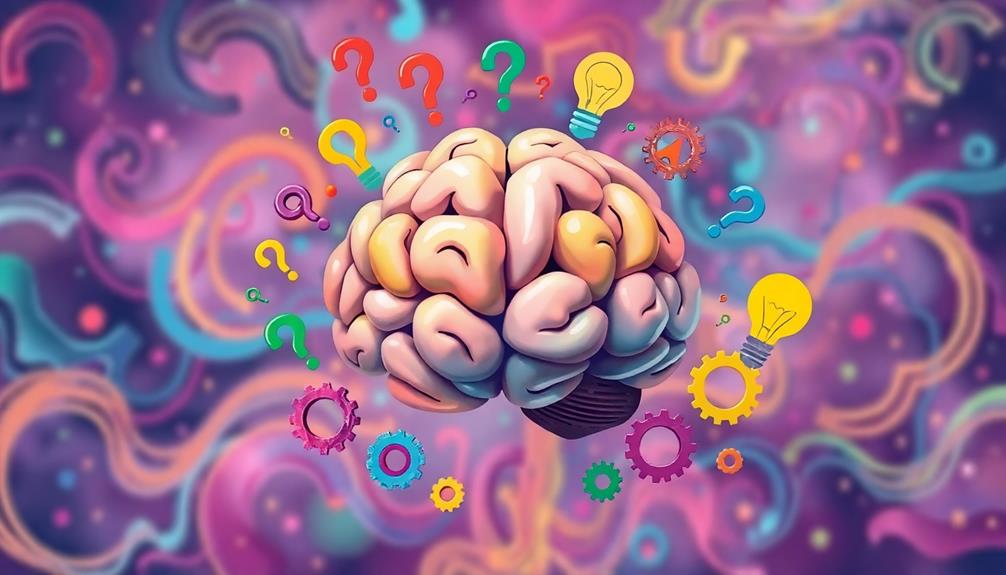Optical illusions hack your visual cortex by exploiting how your brain quickly interprets visual cues through neural shortcuts and contextual assumptions. They manipulate the way your nervous system processes shapes, depth, and motion, tricking your perception into seeing something false. Your brain relies on prior experiences and rapid processing, which makes it vulnerable to these tricks. If you keep exploring, you’ll discover how your brain’s wiring can be fooled and the secrets behind these fascinating illusions.
Key Takeaways
- Optical illusions exploit stages of visual processing, causing the brain to misinterpret cues like depth and size.
- They manipulate neural shortcuts in the visual cortex, leading to perceptual errors and distorted perceptions.
- Illusions often involve ambiguous or conflicting stimuli that confuse neural circuitry during interpretation.
- By targeting underlying neural pathways, illusions reveal how the brain constructs a coherent but sometimes false visual reality.
- They demonstrate how the brain’s active interpretation process can be hijacked to produce false perceptions.

Optical illusions captivate our minds by tricking our eyes into perceiving something different from reality, revealing how our visual system processes complex images. When you look at these illusions, you’re witnessing firsthand how perception distortion occurs, highlighting the brain’s tendency to interpret visual cues in unexpected ways. These illusions expose a fascinating aspect of our neural architecture: neural misinterpretation. Your brain receives visual signals through your eyes and constructs a coherent picture of the world. However, in some cases, it misreads or overinterprets these signals, leading to perceptual errors. This neural misinterpretation isn’t a flaw but part of how your visual system handles a vast amount of information rapidly. Your brain relies on prior knowledge, context, and assumptions to interpret what your eyes see, which can sometimes result in a distorted perception. For example, when you view a famous optical illusion like the Müller-Lyer, your brain struggles to reconcile the length of the lines because it interprets arrowheads as cues for depth or distance. This causes a perception distortion, making one line seem longer or shorter than the other, even though they are identical. Your neural pathways are wired to make quick judgments, and these shortcuts can be fooled by clever visual tricks. Moreover, these illusions demonstrate how your brain employs perceptual shortcuts to process visual information efficiently, which can sometimes lead to errors. The illusion’s power lies in how it exploits the normal functioning of your visual cortex. Your brain processes visual information in stages, from detecting basic shapes to interpreting complex patterns. Illusions often target these stages, creating a mismatch between what your eyes see and what your brain perceives. It’s as if your neural circuitry gets temporarily confused, misinterpreting signals and producing a false perception. This process reveals that your visual system is not merely a passive recorder but an active interpreter, prone to errors when faced with ambiguous or conflicting stimuli. As you experience optical illusions, you see how your perception can be distorted intentionally. They remind you that your visual system is susceptible to neural misinterpretation, which can be manipulated for entertainment, art, or scientific research. The next time you stare at a moving spiral or a impossible figure, remember that your brain is working hard to decode what it’s seeing, but sometimes, it’s led astray by clever tricks designed to expose the quirks of your visual cortex. These illusions aren’t just mind games—they reveal the intricate and sometimes fallible nature of how you perceive the world around you.
Frequently Asked Questions
Can Optical Illusions Be Used to Diagnose Neurological Disorders?
You might wonder if optical illusions can diagnose neurological disorders. They do, because they reveal how your neural plasticity and perceptual training shape perception. When your brain responds abnormally to illusions, it signals potential issues in neural pathways. Doctors use these responses as diagnostic tools, helping identify conditions like schizophrenia or visual processing disorders. Optical illusions therefore serve as valuable, non-invasive ways to assess your brain’s health and functioning.
How Do Individual Differences Affect Perception of Optical Illusions?
You might think optical illusions fool everyone equally, but your perception variability and individual biases make the experience unique. Ironically, these differences mean what confuses you might not even register with someone else. Your brain’s wiring and past experiences shape how you interpret illusions, proving that perception is less about the illusion itself and more about your personal mental filters. So, yes, perception varies, making illusions a fascinating mirror of individual minds.
Are There Cultural Factors Influencing How We Perceive Illusions?
You might notice that cultural interpretation shapes how you perceive optical illusions, as different backgrounds influence your visual expectations. Artistic influence also plays a role, as exposure to certain styles can alter your perception. These factors cause your brain to interpret illusions differently, highlighting that perception isn’t purely biological but also shaped by your cultural experiences and artistic exposure. This makes understanding illusions a fascinating blend of science and cultural context.
Can Repeated Exposure to Illusions Improve Visual Processing Skills?
Perceptual training promises to boost your visual acuity through repeated exposure to illusions. By intentionally challenging your brain with tricky visuals, you stimulate your visual cortex, sharpening your sight and sensory skills. As you practice, you’ll notice your perception becoming more precise, empowering your ability to interpret images accurately. Repeatedly engaging with illusions can release enhanced visual processing, turning confusing tricks into clear, confident perceptions.
Do Optical Illusions Have Any Impact on Brain Development in Children?
You might wonder if optical illusions influence brain development in children. While their primary role is to challenge visual perception, they can also stimulate cognitive development by encouraging problem-solving and critical thinking. Engaging with illusions helps children understand how their brains interpret images, fostering neural connections. So, yes, optical illusions can positively impact a child’s brain growth by enhancing visual perception skills and supporting cognitive development.
Conclusion
By now, you’ve seen how optical illusions reveal the incredible tricks your visual cortex can play on your mind. Did you know that your brain processes visual information at about 13 milliseconds? That quick! So, next time an illusion surprises you, remember it’s your brain’s amazing ability to interpret and sometimes deceive itself. Embrace the wonder of your own mind—these illusions remind you just how fascinating and complex your visual system truly is.









